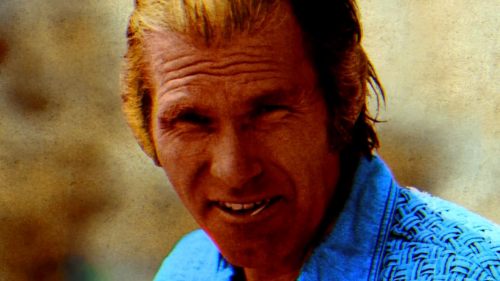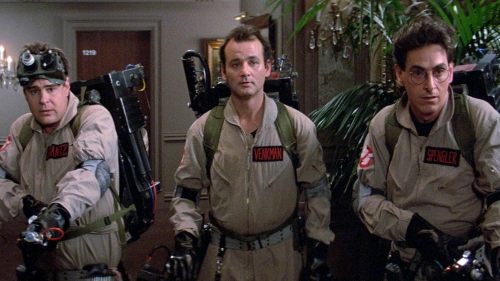Collins’ Crypt: Horror Sequels Are Damned If They Do, Damned If They Don’t
Earlier this week I was a guest on a podcast where the topic of discussion was Wes Craven's New Nightmare, which I consider to be one of the best entries in the series (after only the original and Dream Warriors) and was happy to see that it mostly holds up, over 25 years later. It can be a bit sluggish (it's just under two hours) and some of the ideas don't have satisfying payoffs, but it hasn't dated itself like many of the other sequels, and I like that there was a real attempt to make these movies scary again. It's also far more creative than a "Part 7" should be; the idea that the previous six films (which, in this film's real-world universe, are just movies) were keeping an actual demonic entity at bay and now that evil has escaped due to New Line Cinema killing the character off is a terrific concept, far more interesting than "Well, this time...Freddy has...a Power Glove?"
But whatever acclaim and goodwill it has accumulated over the years, one has to remember that the film kind of tanked upon release in 1994. The marketing campaign didn't hide that Wes Craven and other people were in the film playing themselves, but it also had Robert Englund in full Freddy makeup, speaking directly to camera saying "Miss me?", which when stripped of its in-film context looks like Krueger is announcing his full-blown return. However, the character we know doesn't actually appear in the film - it's a demonic entity taking the form of Freddy, as opposed to the child-murderer turned dream stalker who is taking revenge on the children of Springwood, Ohio. In other words, it's NOT "Nightmare on Elm Street Part 7" even though that's probably what audiences - and maybe even New Line - would have preferred, and it's certainly what many expected.
In fact, I started wondering if the film would have played better for people who had never seen a Nightmare film at all, as they wouldn't have any expectations for what should happen in one. Again, since it's not a direct sequel there's no need to see any of the others, even the original - as long as you're aware of a popular series of horror movies about a guy named Freddy Krueger, you'll be more than prepared. Since Craven had no involvement with any of the sequels beyond writing the earlier drafts of Dream Warriors, it makes sense that New Nightmare isn't reference-heavy; the films are spoken of in general terms and its idea of "fan service" is having New Line executive Sara Risher play herself. When Heather Langenkamp is approached to star in a new entry of the series, she doesn't even question how that would work since - as fans would know - her character is dead. That'd be too "sequel-y" for this movie, I suspect.

Long story short, its existence may have been due in part to the box office rebound the series made with Freddy's Dead, but it really wasn't aimed at anyone who saw and enjoyed that entry - this film's themes, older characters, and minimal appearances of Freddy (with zero wisecracks) were aimed at adults, i.e. the people who were old enough to see the R-rated original ten years prior and were now in their late 20s, early 30s, perhaps with children and/or homes of their own. Over that time, they had grown and matured, and when they revisited the first Elm Street they would conceivably be closer in age to Don and Marge Thompson than Nancy. Whether it was his conscious intention or not, Craven's film was far more likely to appeal to them than the still teens (or early 20s) who flocked to the goofy Freddy's Dead three years earlier.
That approach must be one of the questions that has to come up whenever a sequel is being developed: do they make it for the fans of the earlier film(s), or do they aim at the demographic of people who made that film a hit in the first place? Ideally, the answer would be "both", but the more time that passes from the first (presumably best/favorite) film, the harder it is to find that line as the original "kids" of the audience will now be "adults". 90% (more?) of sequels fail to make as much money as their predecessors, and there are many reasons why - most of which are basically "the sequel didn't have the thing I liked about the original." Maybe it was a particular actor who didn't return, or it was the unique concept that is now old hat; perhaps it was just released during a heatwave and folks wanted deluxe air conditioning so they didn't really care what they were seeing and certainly didn't need to come back for another one. Beyond releasing the same film again and adding a "2" to its title, no matter what you do there's going to be someone who feels that it lacks the je ne sais quoi that roped them in the last time, so the trick is to figure out how to get someone else to take their place.
I would have loved to have been privy to such discussions at Screen Gems and Ghost House as they developed last weekend's The Grudge, which despite the title's simplicity was NOT a remake but essentially Grudge 4, as it took place in the same continuity as the 2004 smash and its less popular sequels, though it (thankfully) didn't bother picking up any of their direct story threads or characters. Since it had been a decade since the last entry - and fifteen since the original (which is probably the only one the average person saw, since 2006's Grudge 2 only grossed about a third of what the first one did and Grudge 3 went direct to video entirely) - it certainly wouldn't be unreasonable for Sony to start over (ESPECIALLY Sony, since Tobey Maguire was still Spider-Man the last time they made a Grudge movie). Instead, they took a cue from New Nightmare and, rather than cater to today's teens, made a film that would go over better with the people who were old enough to see the 2004 film in theaters and are now grown adults who find younger audiences at horror movies to be the bane of their existence. The studio even made it for an R rating, an upgrade from the PG-13 others, to hammer home that they didn't care if a 15-year-old wanted to see it.

Indeed I was kind of stunned to see that Grudge '20 had no teen or even young adult characters of any sort; hell, even New Nightmare had the 23-ish babysitter, but here apart from the barely seen young son of the main character (played by Mandy herself, Andrea Riseborough) the youngest cast member is in their mid-30s, with most of them much older than that (including Lin Shaye, who - full circle alert - also appeared in New Nightmare). The film's F Cinemascore and subsequent box office (much lower than initial expectations) suggest that the audience who did show up did not get what they were expecting, i.e. something more traditionally "exciting", with dozens of jump scares (the new film had relatively few) and someone like Sarah Michelle Gellar to take the journey with. Clearly, they were hoping that the audience that turned the 2004 film into such a huge success - now fifteen years older and hopefully wiser - would show up and appreciate something adult leaning and dramatic, as if the franchise had grown along with them.
And you can't really blame them for trying, as 2017's Rings did the opposite thing and aimed at teens who would have been infants when the first film hit in 2002, yet couldn't manage to interest the next generation either, suggesting it wasn't a good strategy. But on paper it seemed like a safe plan to rope in the 13-25 demographic; its heroes were a couple of college students going through the same motions as Naomi Watts did in the other films, uncovering yet another tragic chapter in Samara's history while racing against the clock before their time was up. It was the normal sequel approach - "more of the same!" - but from my perspective, there was never much of an interest in it even if it was good (it wasn't), as too much time had passed since the last entry and the "haunted ______" trope had been done to death by Ring's imitators in the fifteen years between, making it feel like a relic instead of being able to cash in on the once-lucrative brand name (see also: 2016's Blair Witch).
Ultimately, the best solution is to simply make a movie that the makers are happy with and proud of, and hope that audiences show up - if not on opening weekend, at least down the road a bit (something easier to do with the cheaper horror movies than billion-dollar franchises like Star Wars). Pandering is just as likely to fail as succeed, so there's no real benefit to it, especially if you want to look at the big picture as it might make a few bucks but won't be remembered as fondly and could tarnish a brand (it's interesting that a film like 2018's Halloween revival was seen as "fixing" a franchise that had never lost money). New Nightmare may have flopped at the time, but let's consider that it has a higher rating (and more views logged) than Dream Master - the series' highest grosser - on Letterboxd, which of course didn't exist at the time; in other words, it's had the longevity a studio should ultimately want for their films, and found the people who could appreciate it who might not have even been able to see it then. I wouldn't bet heavily on The Grudge following suit (it's not a great movie, by any means - just better than the 1-star types would have you believe), but I walked out of the theater feeling that they were at least aiming to please me, the 40-year-old who has zero interest in jump scares, rather than the clearly bored 20ish girl behind me who loudly sighed more than once. Then I wrote an article thanking them! That's gotta soften the blow, right?



